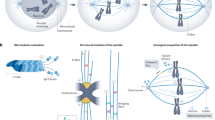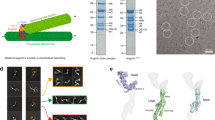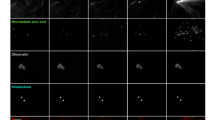Abstract
The mitotic spindle of the budding yeast Saccharomyces cerevisiae will probably be the first such organelle to be understood in molecular detail. Here we describe the mitotic spindle cycle of budding yeast using electron-microscope-derived structures and dynamic live-cell imaging. Recent work has revealed that many general aspects of mitosis are conserved, making budding yeast an excellent model for the study of mitosis.
This is a preview of subscription content, access via your institution
Access options
Subscribe to this journal
Receive 12 print issues and online access
$209.00 per year
only $17.42 per issue
Buy this article
- Purchase on Springer Link
- Instant access to full article PDF
Prices may be subject to local taxes which are calculated during checkout



Similar content being viewed by others
References
Robinow, C. F. & Marak, J. A fiber appartus in the nucleus of the yeast cell. J. Cell Biol. 29, 129–150 (1966).
Byers, B. & Goetsch, L. Duplication of spindle plaques and integration of the yeast cell cycle. Cold Spring Harb. Symp. Quant. Biol. 38, 123–131 (1974).
Byers, B. & Goetsch, L. Behavior of spindles and spindles plaques in the cell cycle and conjugation of Saccharomyces cerevisiae. J. Bacteriol. 124, 511– 523 (1975).
Peterson, J. & Ris, H. Electron-microscopic study of the spindle and chromosome movement in the yeast Saccharomyces cerevisiae . J. Cell Sci. 22, 219– 242 (1976).
Kilmartin, J. & Adams, E. Structural rearrangements of tubulin and actin during the cell cycle of the yeast Saccharomyces. J. Cell. Biol. 98, 922–933 (1984).
Goshima, G. & Yanagida, M. Establishing biorientation occurs with precocious separation of the sister kinetochores, but not the arms, in the early spindle of budding yeast. Cell 100 , 619–633 (2000).
He, X., Asthana, S. & Sorger, P. K. Transient sister chromatid separation and elastic deformation of chromosomes during mitosis in budding yeast. Cell 101, 763–775 ( 2000).
Straight, A., Marshall, W., Sedat, J. & Murray, A. Mitosis in living budding yeast: anaphase A but no metaphase plate. Science 277, 574–578 (1997).
Maddox, P. S., Bloom, K. S. & Salmon, E. D. The polarity and dynamics of microtubule assembly in the budding yeast Saccharomyces cerevisiae. Nature Cell Biol. 2, 36–41 ( 2000).
Guacci, V., Hogan, E. & Koshland, D. Centromere position in budding yeast: evidence for anaphase A. Mol. Biol. Cell 8, 957– 972 (1997).
Tanaka, T., Fuchs, J., Loidl, J. & Nasmyth, K. Cohesin ensures bipolar attachment of microtubules to sister centromeres and resists their precocious separation. Nature Cell Biol. 2, 492–499 (2000).
West, R. R., Vaisberg, E. V., Ding, R., Nurse, P. & McIntosh, J. R. cut11(+): a gene required for cell cycle-dependent spindle pole body anchoring in the nuclear envelope and bipolar spindle formation in Schizosaccharomyces pombe. Mol. Biol. Cell 9, 2839–2855 (1998).
Chial, H. J., Rout, M. P., Giddings, T. H. & Winey, M. Saccharomyces cerevisiae Ndc1p is a shared component of nuclear pore complexes and spindle pole bodies. J. Cell Biol. 143, 1789–1800 (1998).
Ding, R., McDonald, K. & McIntosh, R. Three-dimensional reconstruction and analysis of mitotic spindles from the yeast, Schizosaccharomyces pombe. J. Cell Biol. 120, 141–151 ( 1993).
Winey, M. et al. Three dimensional untrastructural analysis of the Saccharomyces cereviside mitotic spindle. J. Cell Biol. 129, 1601–1615 (1995).
Bullitt, E., Rout, M., Kilmartin, J. & Akey, C. The yeast spindle pole body is assembled around a central crystal of Spc42p. Cell 89, 1077–1086 ( 1997).
O'Toole, E., Winey, M. & McIntosh, J. R. High-voltage electron tomography of spindle pole bodies and early mitotic spindles in the yeast Saccharomyces cerevisiae . Mol. Biol. Cell 10, 2017– 2031 (1999).
McIntosh, J. R. & Hering, G. E. Spindle fiber action and chromosome movement. Annu. Rev. Cell Biol. 7, 403–426 (1991).
Hildebrandt, E. R. & Hoyt, M. A. Mitotic motors in Saccharomyces cerevisiae. Biochim. Biophys. Acta 1496, 99–116 (2000).
Adams, I. R. & Kilmartin, J. V. Spindle pole body duplication: a model for centrosome duplication? Trends Cell Biol. 10, 329–335 ( 2000).
Wigge, P. A. et al. Analysis of the Saccharomyces spindle pole by matrix-assisted laser desorption/ionization (MALDI) mass spectrometry. J. Cell Biol. 141, 967–977 ( 1998).
Byers, B., Shriver, K. & Goetsch, L. The role of spindle pole bodies and modified microtubule ends in the initiation of microtubule assembly in Saccharomyces cerevisiae . J. Cell Sci. 30, 331– 352 (1978).
Hyams, J. & Borisy, G. Nucleation of microtubules in vitro by isolated spindle pole bodies of the yeast Saccharomyces cerevisiae. J. Cell Biol. 78, 401– 414 (1978).
Adams, I. R. & Kilmartin, J. V. Localization of core spindle pole body (SPB) components during SPB duplication in Saccharomyces cerevisiae. J. Cell Biol. 145, 809– 823 (1999).
Luca, F. C. & Winey, M. MOB1, an essential yeast gene required for completion of mitosis and maintenance of ploidy. Mol. Biol. Cell 9, 29–46 (1998).
Haase, S. B., Winey, M. & Reed, S. I. Multi-step control of spindle pole body duplication by cyclin-dependent-kinase. Nature Cell Biol. 3, 38–42 (2001).
Knop, M. & Schiebel, E. Spc98p and Spc97p of the yeast γ-tubulin complex mediate binding to the spinde pole body via their interaction with Spc110p. EMBO J. 18, 6985–6995 (1997).
Sundberg, H. & Davis, T. A mutational analysis identifies three functional regions of the spindle pole component Spc110p in Saccharomyces cerevisiae. Mol. Biol. Cell 8, 2575–2590 (1997).
Fitch, I. et al. Characterization of four B-type cyclin genes of the budding yeast Saccharomyces cerevisiae. Mol. Biol. Cell 3, 805–818 (1992).
Roof, D. M., Meluh, P. B. & Rose, M. D. Kinesin-related proteins required for assembly of the mitotic spindle. J. Cell Biol. 118, 95–108 (1992).
Vaisberg, E. A., Koonce, M. P. & McIntosh, J. R. Cytoplasmic dynein plays a role in mammalian mitotic spindle formation. J. Cell Biol. 123, 849–858 (1993).
Gonczy, P., Pichler, S., Kirkham, M. & Hyman, A. A. Cytoplasmic dynein is required for distinct aspects of MTOC positioning, including centrosome separation, in the one cell stage Caenorhabditis elegans embryo. J. Cell Biol. 147, 135– 150 (1999).
Heath, I. B. & Rethoret, K. Nuclear cycle of Saprolegnia ferax. J. Cell Sci. 49, 353–367 (1981).
Heath, I. B. Behavior of kinetochores during mitosis in the fungus Saprolegnia ferax . J. Cell Biol. 84, 531– 546 (1980).
McCarroll, R. M. & Fangman, W. L. Time of replication of yeast centromeres and telomeres. Cell 54, 505–513 (1988).
Neff, M. & Burke, D. Random segreation of chromatids at mitosis in Saccharomyces cerevisiae. Genetics 127, 463–473 ( 1991).
Nicklas, R. B. How cells get the right chromosomes. Science 227, 632–637 (1997).
Nasmyth, K., Peters, J. M. & Uhlmann, F. Splitting the chromosome: cutting the ties that bind sister chromatids. Science 288, 1379– 1385 (2000).
O'Toole, E. T. et al. Three-dimensional analysis and ultrastructural design of mitotic spindles from the cdc20 mutant of Saccharomyces cerevisiae. Mol. Biol. Cell 8, 1–11 (1997).
Dej, K. J. & Orr-Weaver, T. L. Separation anxiety at the centromere. Trends Cell Biol. 10, 392–399 (2000).
Sumner, A. T. The structure of the centromeric region of CHO chromosomes. Cell Biol. Int. 22, 127–130 ( 1998).
Waters, J. C., Skibbens, R. V. & Salmon, E. D. Oscillating mitotic newt lung cell kinetochores are, on average, under tension and rarely push. J. Cell Sci. 109, 2823–2831 (1996).
Waters, J. C., Chen, R. H., Murray, A. W. & Salmon, E. D. Localization of Mad2 to kinetochores depends on microtubule attachment, not tension. J. Cell Biol. 141, 1181– 1191 (1998).
Yeh, E., Skibbens, R., Cheng, J., Salmon, E. & Bloom, K. Spindle dynamics and cell cycle regulation of dynein in the budding yeast, Saccharomyces cerevisiae. J. Cell Biol. 130, 687–700 (1995).
Kahana, J. A., Schnapp, B. J. & Silver, P. A. Kinetics of spindle pole body separation in budding yeast. Proc. Natl Acad. Sci. USA 92, 9707–9711 (1995).
Pellman, D., Bagget, M., Tu, H. & Fink, G. Two microtubule-associated proteins required for anaphase spindle movement in Saccharomyces cerevisiae . J. Cell Biol. 130, 1373– 1385 (1995).
Juang, Y-L. et al. APC-mediated proteolysis of Ase1 and the morphogenesis of the mitotic spindle. Science 275, 1311– 1314 (1997).
Jaspersen, S. L., Charles, J. F., Tinker-Kulberg, R. L. & Morgan, D. O. A late mitotic regulatory network controlling cyclin destruction in Saccharomyces cerevisiae. Mol. Biol. Cell 9, 2803–2817 ( 1998).
Hoyt, M. A. Exit from mitosis: spindle pole power. Cell 102, 267–270 (2000).
Rose, M. D. Nuclear fusion in the yeast Saccharomyces cerevisiae. Annu. Rev. Cell. Dev. Biol. 12, 663–695 (1996).
Acknowledgements
We are indebted to C. Pearson and K. Bloom for Fig. 3 and for sharing unpublished data. We thank S. Jones for critical reading of the manuscript, and members of our laboratories for support for our structural analysis. Our structural work is supported by the National Institutes of Health (grant nos GM51312 & GM59992) and the March of Dimes Birth Defects Foundation (FY00-55). The Boulder Laboratory for 3D Fine Structure is a National Research Resource Center (RR00592) under the direction of J. R. McIntosh.
Author information
Authors and Affiliations
Supplementary information
Movie 1a
Duplicating spindle pole body. Serial 2.3-nm tomographic slices of a duplicating SPB in a 300-nm section, as shown in Fig. 2b, animated to allow the viewer to see the series of images through the structure. (MOV 3807 kb)
Movie 1b
Duplicating spindle pole body. The same series of images with model points added. Nuclear (dark blue) and cytoplasmic (light blue) microtubules are indicated, as are the two layers of the duplication plaque (red) and the central plaque of the existing SPB (yellow). These model points are used to generate a three-dimensional model as shown in Fig 1b. (MOV 5241 kb)
Movie 2
Time-lapse movie of transient kinetochore splitting. Images were obtained at 1-s intervals of cell similar to that in Fig. 3 with LacI repressor-GFP bound to a Lac-operator cluster 1 kb from the centromere on chromosome XI; the positions of the SPBs are marked by Spc72-GFP. Selected in-focus frames were used to compose the movie, which includes elapsed time. (MOV 7891 kb)
Rights and permissions
About this article
Cite this article
Winey, M., O'Toole, E. The spindle cycle in budding yeast. Nat Cell Biol 3, E23–E27 (2001). https://doi.org/10.1038/35050663
Issue Date:
DOI: https://doi.org/10.1038/35050663
This article is cited by
-
Cytoskeletal impairment during isoamyl alcohol-induced cell elongation in budding yeast
Scientific Reports (2016)
-
Three wise centromere functions: see no error, hear no break, speak no delay
EMBO reports (2013)
-
Unbiased segregation of yeast chromatids in Saccharomyces cerevisiae
Chromosome Research (2013)
-
Regulatory mechanisms of kinetochore–microtubule interaction in mitosis
Cellular and Molecular Life Sciences (2013)
-
Variations on theme: spindle assembly in diverse cells
Protoplasma (2011)



